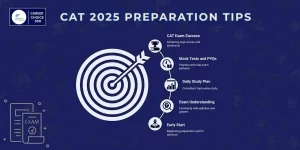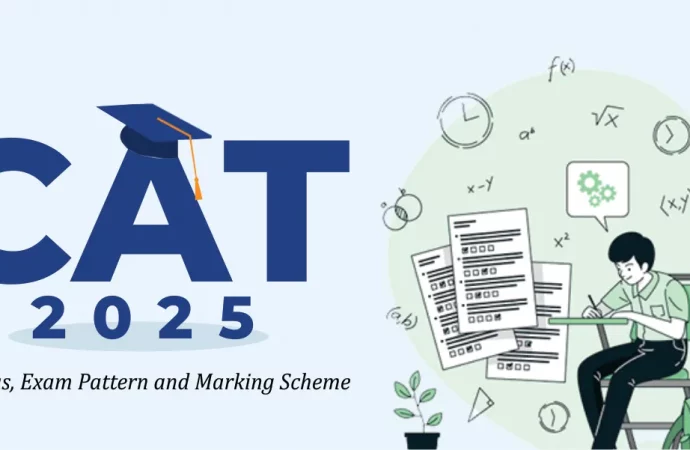Introduction The Common Admission Test (CAT) is one of the most important and competitive examinations for students aiming to pursue management education in India. Conducted annually by the Indian Institutes of Management (IIMs), CAT serves as a gateway to admission into prestigious MBA programs offered by IIMs and other leading business schools across the country.
Introduction
The Common Admission Test (CAT) is one of the most important and competitive examinations for students aiming to pursue management education in India. Conducted annually by the Indian Institutes of Management (IIMs), CAT serves as a gateway to admission into prestigious MBA programs offered by IIMs and other leading business schools across the country. The exam evaluates not only a candidate’s academic knowledge but also critical thinking, analytical skills, problem-solving abilities, and time management – all of which are essential for a successful career in management.
For CAT 2025, the examination is scheduled to be held on November 30, 2025. With the growing competition and increasing number of aspirants, it is essential for candidates to have a comprehensive understanding of the exam pattern, syllabus, eligibility criteria, and preparation strategies to maximize their chances of securing a high percentile and admission into top management institutes.
The Common Admission Test (CAT) is one of the most important and competitive examinations for students aiming to pursue management education in India. Conducted annually by the Indian Institutes of Management (IIMs), CAT serves as a gateway to admission into prestigious MBA programs offered by IIMs and other leading business schools across the country. The exam evaluates not only a candidate’s academic knowledge but also critical thinking, analytical skills, problem-solving abilities, and time management – all of which are essential for a successful career in management.
For CAT 2025, the examination is scheduled to be held on November 30, 2025. With the growing competition and increasing number of aspirants, it is essential for candidates to have a comprehensive understanding of the exam pattern, syllabus, eligibility criteria, and preparation strategies to maximize their chances of securing a high percentile and admission into top management institutes.
Exam Pattern of CAT 2025

Image by: Yandex.com
The CAT 2025 exam will be conducted in a computer-based format and will consist of three sections, each designed to test specific skill sets:
1. Verbal Ability and Reading Comprehension (VARC): 24 questions
This section assesses the candidate’s command over the English language, reading comprehension abilities, and analytical skills. It includes reading comprehension passages, para-jumbles, sentence correction, grammar-based questions, and vocabulary-based problems. Reading comprehension makes up the majority of this section, so regular practice of diverse passages is essential.
2. Data Interpretation and Logical Reasoning (DILR): 20 questions
The DILR section tests the candidate’s ability to interpret data and solve logical problems. Questions include tables, charts, graphs, caselets, puzzles, seating arrangements, and other reasoning-based problems. Strong analytical skills, attention to detail, and consistent practice of previous years’ questions are vital to score well in this section.
3. Quantitative Aptitude (QA): 22 questions
QA evaluates mathematical and numerical problem-solving skills. Topics include arithmetic, algebra, geometry, number systems, probability, percentages, ratio and proportion, and basic statistics. Efficient calculation, familiarity with formulas, and shortcut methods can help candidates manage time effectively and answer questions accurately.
The total duration of CAT 2025 is 120 minutes, with each section having a specific time limit. Candidates cannot switch sections until the allocated time for a section ends. The marking scheme includes +3 marks for each correct answer, -1 mark for each incorrect answer, while non-MCQ questions do not carry negative marking. Sectional time management is key to attempting the maximum number of questions accurately.
Eligibility Criteria for CAT 2025
Aspirants must meet certain eligibility requirements to appear for CAT 2025:
- Educational Qualification: Candidates must hold a bachelor’s degree from a recognized university or institution with at least 50% marks (45% for SC/ST/PwD candidates).
- Final Year Students: Those in the final year of their undergraduate program are also eligible to apply.
- Age Limit: There is no age limit, allowing both fresh graduates and working professionals to appear for the exam.
Meeting these eligibility criteria is crucial to avoid disqualification at a later stage.
CAT 2025 Registration Process
The registration for CAT 2025 is conducted online through the official CAT website. Candidates need to:
- Create a user ID and password
- Fill in personal, educational, and contact details accurately
- Upload scanned copies of photograph and signature according to the specifications
- Pay the application fee: ₹2,600 for General/EWS/OBC candidates and ₹1,300 for SC/ST/PwD candidates
Candidates are advised to complete the registration well before the last date to avoid technical issues or last-minute errors. Regularly checking the official CAT website for updates is also recommended.
Preparation Strategies for CAT 2025
Effective preparation is the key to cracking CAT 2025 with a high percentile. Here are some recommended strategies:
- Create a Study Plan: Allocate dedicated time for each section based on your strengths and weaknesses. For example, if VARC is your weakest section, dedicate more daily time to reading comprehension and grammar exercises.
- Practice Mock Tests: Mock tests simulate real exam conditions, helping candidates manage time, assess strengths and weaknesses, and understand the exam’s difficulty level. Attempting full-length tests regularly is essential to improve stamina and accuracy.
- Analyze Previous Years’ Papers: Reviewing past question papers helps identify frequently asked topics, question types, and difficulty patterns. This analysis helps candidates develop targeted strategies for preparation.
- Develop Reading and Comprehension Skills: Reading newspapers, articles, journals, and online blogs enhances vocabulary, comprehension, and analytical reading abilities, which are essential for VARC.
- Focus on Quantitative Shortcuts: Learning formulas, shortcut methods, and tricks for calculations helps save valuable time in the QA section. Practice is critical to apply these methods effectively during the exam.
- Enhance Logical Reasoning Skills: Regular practice of puzzles, seating arrangements, and reasoning exercises improves problem-solving speed and accuracy in DILR.
- Time Management: Learn to allocate time wisely between sections and questions. Practicing with a timer will improve speed and ensure that all questions are attempted within the allotted time.
- Consistency is Key: Consistent daily practice is more effective than last-minute cramming. Regular study sessions build confidence and reduce exam anxiety.
- Consider Coaching or Online Courses: For candidates struggling in specific sections, coaching institutes or online programs can provide structured guidance, expert tips, and additional resources.
- Take Care of Mental and Physical Health: Maintaining a healthy routine with sufficient sleep, exercise, and breaks is crucial for optimal performance during preparation and on exam day.
Final Thoughts
CAT 2025 is not just a test of knowledge but also a test of strategy, time management, and mental agility. Understanding the exam pattern, following a disciplined preparation plan, practicing regularly, and analyzing performance consistently are critical to achieving a high percentile. With dedication, strategic planning, and consistent effort, candidates can enhance their chances of securing admission into top IIMs and other leading management institutes. Success in CAT requires a combination of hard work, intelligent preparation, and mental resilience. Aspirants who prepare thoughtfully and practice diligently are more likely to achieve their goals and take the first step toward a successful career in management.
















